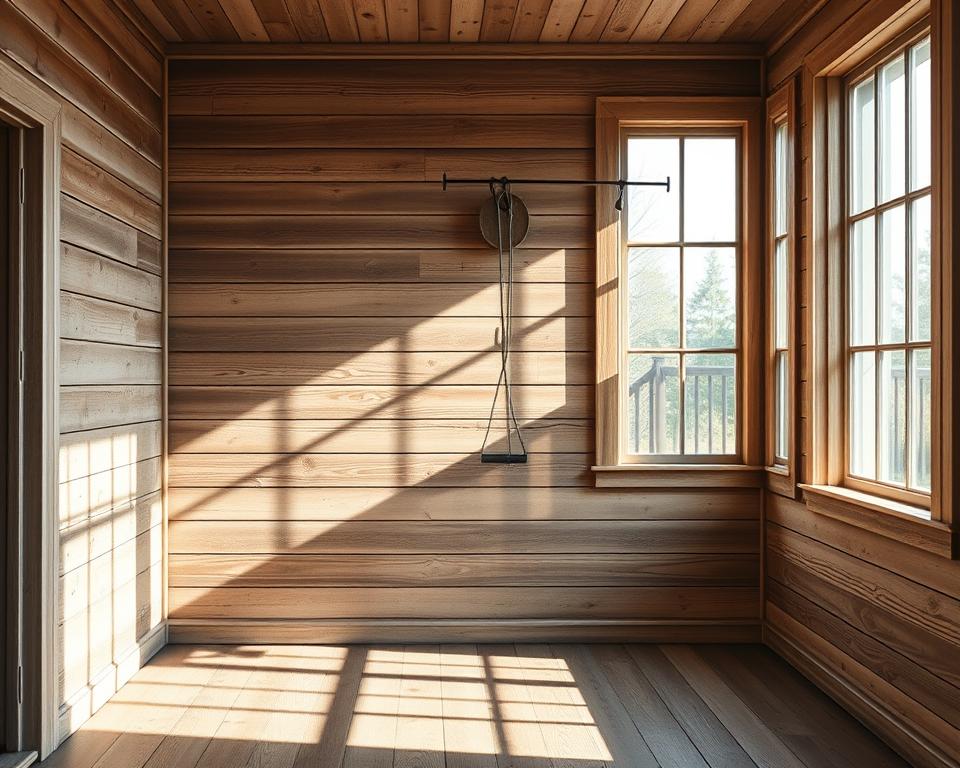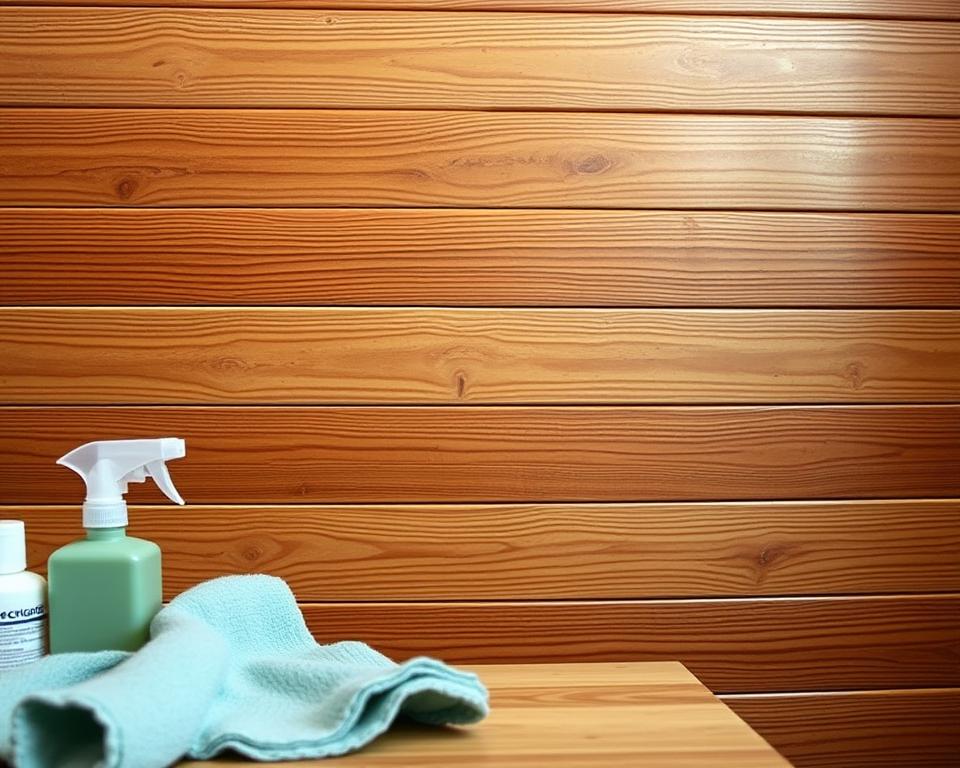Shiplap walls have gained popularity for their ability to infuse rustic charm into any space. They make rooms feel cozier and more welcoming. The horizontal panels and overlapping edges of shiplap walls add warmth and texture, unlike other design elements. By embracing shiplap wall design, you can turn any room into a cozy retreat.
ComfyIdeas.com notes that shiplap walls bring rustic charm and elegance to any room. They can serve as accent walls or ceilings, offering versatility in home decor. While white shiplap is popular for its clean look, bold colors can create striking features. Shiplap walls add texture and depth, making them ideal for those seeking design inspiration.
Introduction to Shiplap Walls
Shiplap walls are increasingly favored by homeowners, contributing to a growing trend in interior design. They add texture and depth, making them perfect for creating a unique and inviting atmosphere. Whether you prefer classic white shiplap or bold colors, there are numerous shiplap wall ideas to explore.
Key Takeaways
- Shiplap walls can add rustic charm and elegance to any room
- Shiplap can be used to create accent walls or ceilings, providing versatility in home decor
- Incorporating shiplap can enhance the visual interest of a room by adding texture and depth
- Shiplap wall design is all about creating a unique and inviting atmosphere
- Shiplap walls are relatively easy to maintain, requiring simple cleaning for painted surfaces and periodic sealing for natural wood
- Shiplap can be combined with other materials, such as beadboard or stone accents, to create layered visual interest in larger living rooms
What Are Shiplap Walls?
Shiplap walls are a design feature that involves installing horizontal panels with overlapping edges. This creates a sense of texture and warmth, adding depth and character to any room. Shiplap wall design experts note that this style has been used for centuries, mainly in shipbuilding. It has recently become popular in home design, fitting well with rustic and country-style decor.
The materials for shiplap walls vary, including natural wood, painted wood, and metal. Natural wood shiplap, like pine, is strong and affordable. Cedar, on the other hand, resists rot and decay, making it perfect for outdoor use. For a modern look, DIY shiplap walls can be made with vinyl planks. These are durable and require little maintenance.
The process of shiplap wall installation is simple, needing no special tools. This allows homeowners to save on labor costs by doing the job themselves. Installing shiplap can make a space feel up to 30% larger, thanks to its horizontal layout. It works well in high-moisture areas like bathrooms and kitchens, provided moisture-resistant materials are used.
The History of Shiplap
Shiplap’s history is both rich and captivating, spanning over a millennium. Initially, it served as a practical solution to protect walls from moisture and drafts. Its origins trace back to the Viking era, around 1,700 years ago. Back then, shiplap consisted of thin wood boards with overlapping joints, sealing out wind and weather.
As time went on, shiplap transformed into a sought-after design element. It became a staple in coastal and rural homes for its durability against harsh weather. Today, it adorns various spaces, from modern kitchens to rustic living rooms. It’s a favorite for shiplap wall decor and shiplap wall paneling. Homeowners now have a plethora of options when selecting the best shiplap for walls.
The “Catastrophe House” from “Fixer Upper” is a prime example of shiplap’s historical importance, built in 1911. Its popularity as a decorative element began in 2013, with the show’s first season. Designer Jodi Medina remarks that shiplap remains as sought-after as ever, now featured in modern homes like those along Lake Michigan.
Origins and Evolution
The roots of shiplap date back to ancient times, with the Nydam boat from 320 AD being the earliest known example of clinker construction. Over the years, shiplap has evolved into a beloved design feature. It’s now a staple in many projects, cherished for its unique look and lasting durability.
Why Choose Shiplap Walls?
Shiplap wall paneling has gained popularity among homeowners for its unique look and versatility. Its horizontal panels and overlapping edges add texture and warmth, ideal for cozy, rustic areas. ComfyIdeas.com notes that shiplap walls can bring a cozy, farmhouse vibe to living rooms, bedrooms, and kitchens.
One key advantage of shiplap walls is their affordability. Using materials like pine or composite options makes them durable and low-maintenance. They also blend well with existing décor, making them perfect for those who want to enhance their space without a full renovation.
Some of the benefits of shiplap walls include:
- Easy to install and maintain
- Can be painted any color to match existing décor
- Offers excellent durability and strength, supporting up to 200 pounds per square foot
- Can be used in a variety of design contexts, from modern farmhouse kitchens to rustic cabin living rooms
Overall, shiplap walls are an excellent choice for homeowners seeking a unique, rustic touch. Their affordability, versatility, and ease of installation make them a favorite among many.
Different Styles of Shiplap
Shiplap wall design has evolved, offering homeowners a variety of styles to match their taste and decor. The material used in shiplap significantly influences the space’s look and feel. Traditional shiplap often employs natural wood, whereas modern shiplap may include materials like metal and reclaimed wood.
The finish of shiplap is another crucial aspect. Homeowners can choose between a painted finish for a vibrant color or a natural finish to highlight the wood’s beauty. DIY shiplap walls allow for a personal touch, achievable with the right tools and materials. Shiplap wall installation is relatively straightforward, thanks to online tutorials and guides.
- Traditional horizontal shiplap
- Modern vertical shiplap
- Painted shiplap
- Natural finish shiplap
These styles can transform any room, from a cozy bedroom to a spacious living area. By selecting the appropriate style and material, homeowners can craft a space that reflects their personal taste and style.
Installation Process for Shiplap Walls
Installing shiplap walls can be a fun and rewarding DIY project, or it can be left to the professionals. According to mymoderncave.com, the installation process involves several key steps. Homeowners will need a few basic tools and materials, including a level, a hammer, and a saw.
A successful shiplap wall installation requires careful planning and attention to detail. The process begins with preparing the wall surface, followed by measuring and cutting the shiplap panels. It is essential to add 10 percent to the total square footage of the wall to account for waste when calculating the amount of shiplap needed.
- Using a level to ensure the first row of shiplap is straight
- Placing a nail through the top and bottom of each shiplap board where it crosses a stud
- Using nickel spacers to maintain a consistent gap between rows
- Staggering boards in cuts from row to row to enhance visual appeal and structural integrity
By following these steps and considering these key factors, homeowners can achieve a beautiful, professional-looking shiplap wall decor. This adds a touch of rustic charm to any room. With the right tools and materials, a DIY shiplap walls project can be a cost-effective and rewarding way to enhance the beauty of a room.
Maintenance Tips for Shiplap
Shiplap walls bring a rustic charm to any room, but they need regular care to stay in top condition. Cleaning your shiplap wall decor is crucial. Use a gentle cleaning solution to avoid damaging the wood. A mix of 1 cup vinegar to 2 cups warm water is a good, eco-friendly option for cleaning shiplap wall paneling.
To maintain your shiplap walls, avoid harsh chemicals and abrasive cleaners. Keep the wall surface dust-free and debris-free. Regular checks for damage, like loose boards or cracks, can prevent further issues. By following these simple steps, your shiplap walls will last for many years.
Here are some additional maintenance tips for shiplap walls:
- Use a microfiber cloth to trap dirt and dust
- Vacuum with a brush attachment for rough-textured shiplap
- Apply a coat of Osmo UV protection every 12 weeks
- Clean shiplap boards every 6 months to enhance appearance and increase lifespan
By adhering to these maintenance tips, you can ensure your shiplap walls remain in excellent condition. Whether you have shiplap wall decor, shiplap wall paneling, or are searching for the best shiplap for walls, consistent upkeep is essential. It helps extend the life of your shiplap walls.
Popular Locations for Shiplap Walls
Shiplap walls bring a rustic charm to any room, making them a versatile design feature. ComfyIdeas.com notes that they can create a cozy, farmhouse-inspired look. This style is ideal for living rooms, bedrooms, and kitchens. Shiplap wall design is a staple in rustic or farmhouse-style homes, a significant trend in interior design.
Some popular locations for shiplap walls include:
- Living rooms and bedrooms, where shiplap can create a cozy, intimate atmosphere
- Kitchens, where shiplap can add a touch of rustic charm and personality to an area often seen as purely functional
- Bathrooms, where proper installation ensures watertightness, thus allowing for more warmth and comfort in typically cold spaces
- Outdoor spaces, where shiplap can be used to create a unique and eye-catching design feature that adds visual interest to a patio or deck
Shiplap walls can make small spaces, like guest bedrooms, more inviting. Light and monochromatic color schemes enhance this effect. The trend of combining painted shiplap with unpainted rustic wood accents is on the rise. This reflects a growing preference for mixed material aesthetics in interior design.
When it comes to shiplap wall ideas, the possibilities are endless. From traditional horizontal layouts to more modern diagonal or vertical installations, shiplap can be used to create a unique and eye-catching design feature in any room. Its versatility and aesthetic appeal make it a popular choice for homeowners looking to add rustic charm to their homes.
Cost of Shiplap Walls
When considering shiplap walls, the cost is a crucial factor. Prices for shiplap materials vary from $2.50 to $7 per square foot, depending on the material type. For instance, pine shiplap boards are more budget-friendly, costing between $2 and $4 per square foot. On the other hand, cedar shiplap boards are pricier, ranging from $5 to $7 per square foot.
For those seeking affordable shiplap walls, there are viable options. Shiplap wall paneling offers a cost-effective route. When combined with the best shiplap for walls, it results in a stunning and lasting finish. The overall cost of installation is influenced by the wood type, installation complexity, and local labor rates.
Here are some estimated costs to consider:
- A shiplap wall costs $240 to $1,700 with installation.
- A shiplap ceiling costs $450 to $2,800 total installed.
- The cost to shiplap a room ranges from $1,200 to $12,100.
By grasping the costs involved and exploring various options, homeowners can find a shiplap wall solution that aligns with their budget and design preferences.
Shiplap Design Inspirations
Exploring shiplap wall ideas reveals a world of endless possibilities. Shiplap can transform modern farmhouse kitchens into cozy retreats or infuse rustic charm into cabin living rooms. It’s a versatile element, suitable for various design contexts, as highlighted by mymoderncave.com.
Vertical shiplap can make rooms appear taller, while horizontal shiplap opens up small spaces. It’s also a great choice for fireplaces, creating stunning focal points. Using shiplap on ceilings adds a sense of continuity, enhancing room harmony.
Seeking shiplap wall design inspiration? Homeowners can explore a range of styles, from farmhouse to modern, rustic to chic. The right design and installation can elevate a space’s aesthetic, creating a warm and welcoming environment.
Trends in Shiplap Wall Design
Shiplap wall design trends are evolving, with a focus on sustainable materials and unique textures. Homeowners and designers are now opting for reclaimed wood and low-VOC paints. These choices not only add an eco-friendly touch but also create a rustic-chic look. Mixing shiplap with materials like brick, stone, or metal is also becoming popular. This adds depth and visual interest to any room.
Interior design experts note that the traditional all-white or cream-colored shiplap is giving way to bolder, moodier shades. This shift allows homeowners to add more character and personality to their homes. Richer paint colors or classic wood stains can keep shiplap looking timeless while following current design trends. The addition of new textures, such as leather and woven fabrics, can also significantly update the look of shiplap-clad spaces.
Homeowners and designers are embracing shiplap’s versatility as design trends evolve. By using sustainable materials and combining them with complementary textures, shiplap remains a timeless choice. It enhances the style and character of any space, making it a versatile and enduring option.
FAQ
What are shiplap walls?
What materials are commonly used for shiplap walls?
What is the history of shiplap walls?
Why should I choose shiplap walls?
What are the different styles of shiplap?
How do I install shiplap walls?
How do I maintain my shiplap walls?
Where can I use shiplap walls?
How much do shiplap walls cost?
Where can I find inspiration for shiplap wall design?
What are the latest trends in shiplap wall design?

Leonardo Freitas is a writer at TrendGaping, specializing in farmhouse-style interiors and sustainable wood decor. He delves into the art of blending rustic elements with modern minimalism, offering tips on how to create cozy, elegant spaces. Through his content, he aims to help readers transform their homes into serene, nature-inspired retreats.



